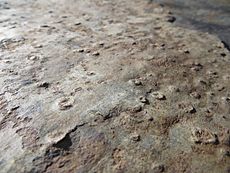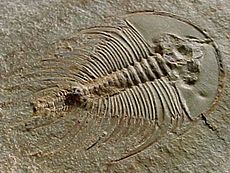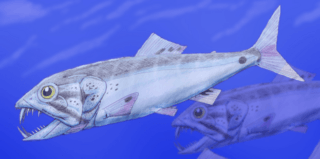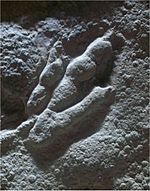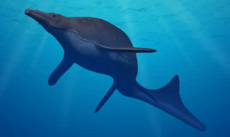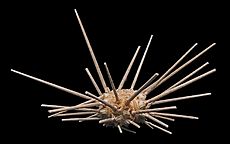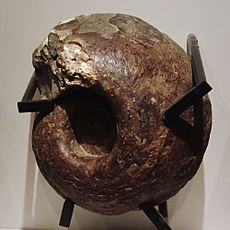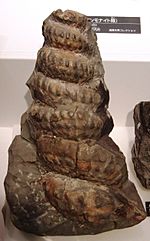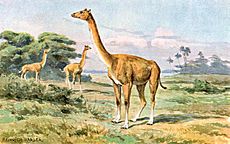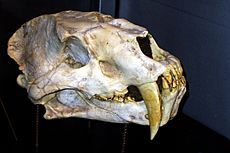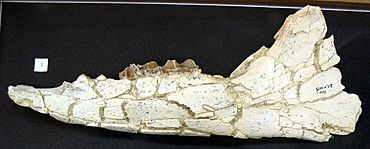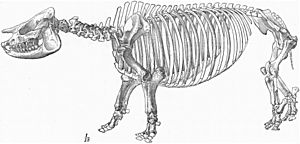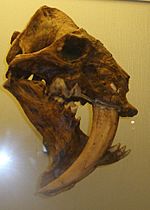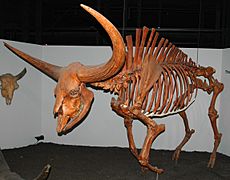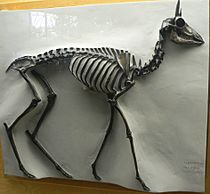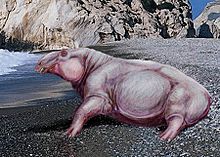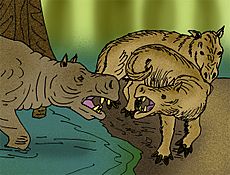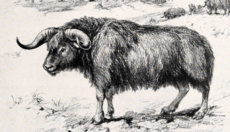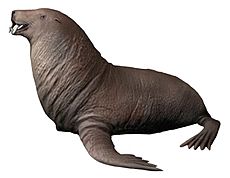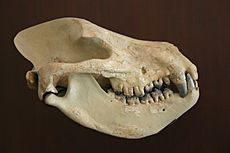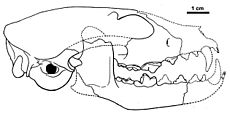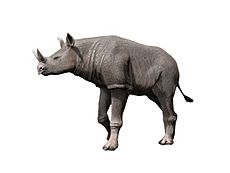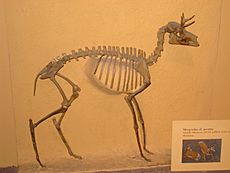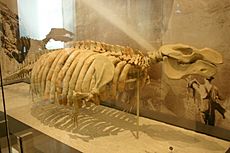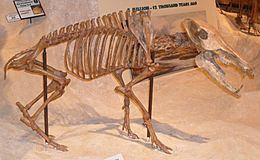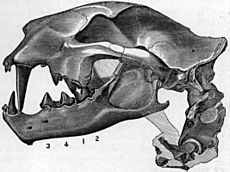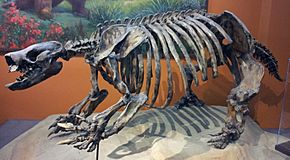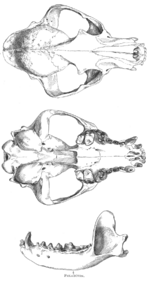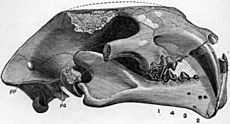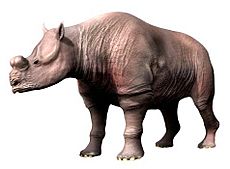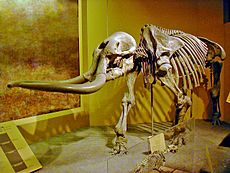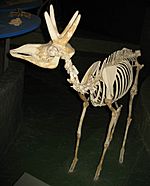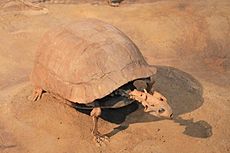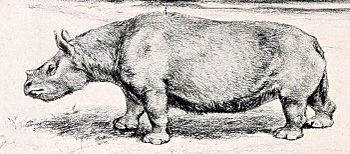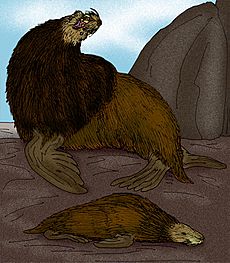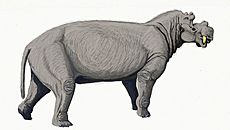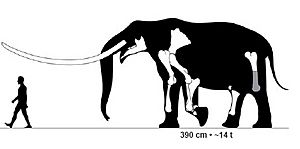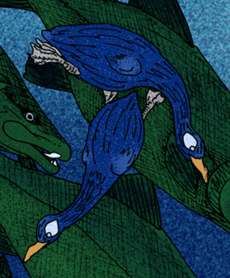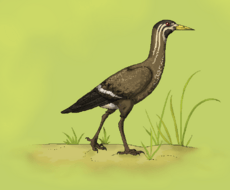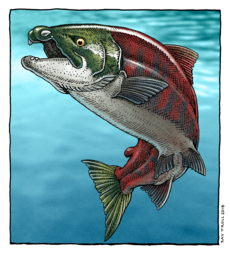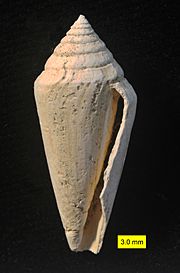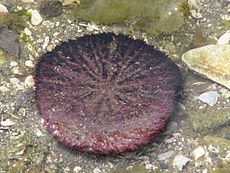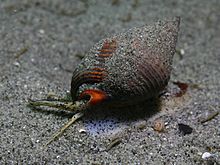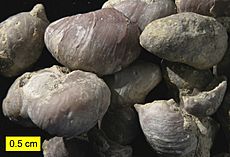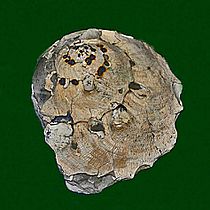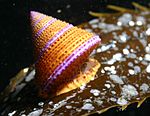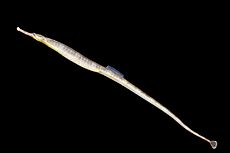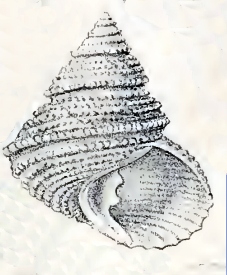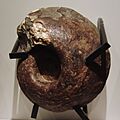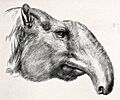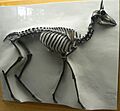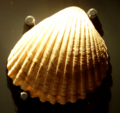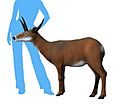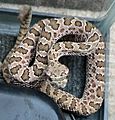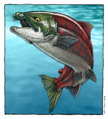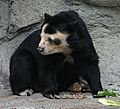List of the prehistoric life of California facts for kids
The prehistoric life of California includes all the amazing ancient plants and animals whose fossils have been found in the state of California. These fossils tell us about creatures that lived millions of years ago, long before humans existed. Scientists study these remains to understand what California was like in the distant past.
Contents
Ancient Eras in California
Precambrian Era: No Life Found Yet
The Precambrian Era was the earliest time in Earth's history. So far, scientists have not found any fossils from this very ancient period in California. This means that if life existed here then, it was too small or soft to leave lasting traces.
Paleozoic Era: Early Ocean Life (541 to 252 Million Years Ago)
The Paleozoic Era was a time when many different kinds of ocean life first appeared. California was mostly covered by warm, shallow seas during this era. Fossils from this period show us creatures like trilobites, brachiopods, and early fish.
Cool Creatures from the Paleozoic Era
- †Advenella: A type of brachiopod, which are shelled creatures that look a bit like clams.
- †Ampyx: A trilobite, an ancient arthropod with a hard, segmented shell.
- †Aspidella: A very old, mysterious organism from the Ediacaran period, which is just before the main Paleozoic era.
- †Atrypa: Another common type of brachiopod.
- †Cruziana: These are not actual animals, but fossilized tracks or burrows left by arthropods (like ancient crabs or insects) moving along the seafloor.
- †Favosites: A type of coral that formed honeycomb-like colonies.
-
†Helicoprion: This was a very unusual shark-like fish with a spiral saw-like tooth whorl in its lower jaw.
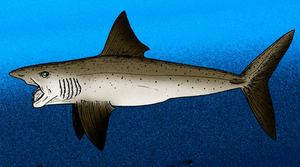 Life restoration of the Permian Chimaera relative Helicoprion
Life restoration of the Permian Chimaera relative Helicoprion - †Kutorgina: An early brachiopod.
- †Lingula: A brachiopod that has survived almost unchanged for millions of years.
- †Olenellus: A well-known trilobite from the Cambrian period.
- †Pentamerus: A large, ribbed brachiopod.
- †Rusophycus: Another type of fossilized burrow or resting trace made by ancient arthropods.
- †Spirifer: A brachiopod with distinctive wing-like extensions on its shell.
- †Xenodiscus: An ammonoid, which was a type of shelled cephalopod related to modern squids and octopuses.
Mesozoic Era: Age of Dinosaurs (252 to 66 Million Years Ago)
The Mesozoic Era is often called the "Age of Dinosaurs." During this time, California's landscape changed a lot. There were large inland seas, and later, volcanoes and mountains began to form. Many marine reptiles and dinosaurs lived here.
Dinosaurs and Reptiles from the Mesozoic Era
- †Aletopelta: An armored dinosaur, a type of nodosaur, found only in California. It was like a walking tank!
- †Augustynolophus: A duck-billed dinosaur (hadrosaur) that also lived only in California. It was a plant-eater.
-
†Californosaurus: A type of ichthyosaur, which were marine reptiles that looked like dolphins.
 Restoration of the Late Triassic ichthyosaur Californosaurus
Restoration of the Late Triassic ichthyosaur Californosaurus - †Cymbospondylus: Another large ichthyosaur, known for its long body.
- †Enchodus: A bony fish with long, saber-like teeth, sometimes called the "saber-toothed herring."
- †Fresnosaurus: A plesiosaur, a long-necked marine reptile. Its fossils were found in Fresno County.
- †Grallator: These are fossilized footprints of small, two-legged (bipedal) dinosaurs, likely theropods.
- †Hydrotherosaurus: A large plesiosaur, a marine reptile with a long neck and flippers.
- †Nectosaurus: A thalattosaur, another type of marine reptile.
- †Plotosaurus: A mosasaur, a giant marine lizard that was a top predator in the Late Cretaceous seas.
- †Shastasaurus: One of the largest ichthyosaurs ever, reaching lengths of over 60 feet (18 meters).
- †Thalattosaurus: Another thalattosaur, known for its unique skull shape.
Other Mesozoic Marine Life
- †Acanthoceras: A type of ammonite, a shelled cephalopod with complex patterns on its shell.
- †Baculites: A straight-shelled ammonite.
- Cidaris: A type of sea urchin.
- †Fagesia: A large, round ammonite.
- †Inoceramus: A very large marine bivalve (like a clam) that could grow to enormous sizes.
- †Mariella: A spiraled ammonite.
-
†Parapuzosia: One of the largest ammonites ever found.
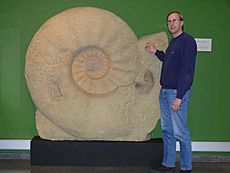 Fossilized shell of the Late Cretaceous ammonoid cephalopod Parapuzosia with a human indicating its size
Fossilized shell of the Late Cretaceous ammonoid cephalopod Parapuzosia with a human indicating its size -
Ostrea: Oysters, which are still around today.
 Shell of an Ostrea, or oyster
Shell of an Ostrea, or oyster -
†Sequoia: Ancient redwood trees, similar to those in California today.
 Base of the trunk of a living Sequoia tree with a human to scale
Base of the trunk of a living Sequoia tree with a human to scale
Cenozoic Era: Rise of Mammals (66 Million Years Ago to Today)
The Cenozoic Era is the most recent era, following the extinction of the dinosaurs. During this time, mammals became the dominant large animals. California's landscape continued to change, with mountain ranges forming and climate shifts. Many familiar animals, or their close relatives, lived here.
Mammals from the Cenozoic Era
- †Acritohippus: An ancient horse.
- †Aepycamelus: A "long-necked camel" from the Miocene, with a very tall neck.
-
†Allodesmus: An ancient seal, a type of pinniped.
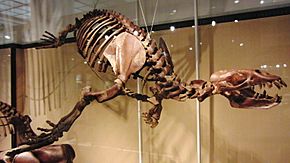 Fossilized skeleton of the Miocene seal Allodesmus
Fossilized skeleton of the Miocene seal Allodesmus - †Amphicyon: A "bear-dog," a large predator that looked like a mix between a bear and a dog.
- †Amphimachairodus: A large saber-toothed cat.
- †Anchitherium: An early three-toed horse.
- †Aphelops: A hornless rhinoceros.
-
†Arctodus: The "short-faced bear," one of the largest bears that ever lived.
 Restoration of an Arctodus, or short-faced bear, with a human to scale
Restoration of an Arctodus, or short-faced bear, with a human to scale - †Aulophyseter: An ancient sperm whale.
- †Balaenula: An ancient baleen whale.
-
†Barbourofelis: A "false saber-toothed cat" with long, flattened fangs.Fossilized skull of the Miocene-Pliocene false saber-toothed cat Barbourofelis
- †Bison latifrons: The "giant bison" or "long-horned bison," much larger than today's bison.
- †Brachycrus: An oreodont, a group of extinct hoofed mammals.
- †Borophagus: A "bone-crushing dog" known for its powerful jaws.
-
†Camelops: The "extinct North American camel."
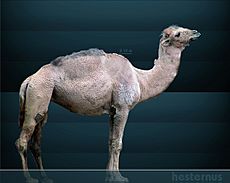 Life restoration of the Pliocene-Holocene camel Camelops
Life restoration of the Pliocene-Holocene camel Camelops - †Capromeryx minor: A "dwarf pronghorn," a small, fast-running antelope-like animal.
- †Canis dirus: The "dire wolf," a famous extinct wolf, larger and more powerful than modern wolves.
- †Cetotherium: An ancient baleen whale.
- †Cranioceras: A relative of modern deer with unusual horns.
- †Daphoenus: Another type of bear-dog.
- †Desmostylus: A unique marine mammal that ate plants, with strange column-like teeth.
- †Duchesneodus: A brontothere, a large, extinct hoofed mammal.
- †Elomeryx: An anthracothere, a pig-like or hippo-like mammal.
- †Euceratherium: The "shrub ox," an extinct bovid.
- †Equus scotti: An extinct horse species.
- †Gomphotaria: An ancient walrus with large tusks.
- †Harpagolestes: A mesonychian, an extinct group of carnivorous mammals.
-
†Hipparion: A three-toed horse.
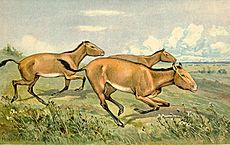 Life restoration of a herd of the Miocene-Pleistocene horse Hipparion. Heinrich Harder (1920).
Life restoration of a herd of the Miocene-Pleistocene horse Hipparion. Heinrich Harder (1920). -
†Homotherium: The "scimitar cat," another type of saber-toothed cat.
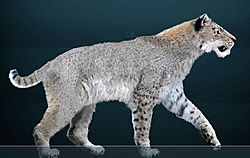 Restoration of Pliocene-Pleistocene Homotherium, or scimitar cat
Restoration of Pliocene-Pleistocene Homotherium, or scimitar cat - †Hydrodamalis cuestae: An extinct giant sea cow, related to manatees and dugongs.
- †Imagotaria: An early walrus.
- †Kentriodon: An ancient dolphin.
- †Leptocyon: An early dog.
- †Limnocyon: A creodont, an extinct group of carnivorous mammals.
- †Machairodus: A saber-toothed cat.
- †Megalonyx: A giant ground sloth.
- †Menoceras: A small, two-horned rhinoceros.
- †Merycodus: An ancient pronghorn.
- †Metaxytherium: A manatee relative.
- †Miracinonyx: The "American cheetah," a fast predator.
- †Mylohyus: An extinct peccary (pig-like animal).
- †Neoparadoxia: Another desmostylian, a marine mammal that ate plants.
- †Nimravus: A false saber-toothed cat.
- †Paramylodon: Another type of ground sloth.
- †Pelagiarctos: A "bear-walrus," an extinct walrus relative.
- †Phlaocyon: A bone-crushing dog.
-
†Platygonus: An extinct peccary.
 Restoration of a herd of alarmed Miocene-Pleistocene peccaries of the genus Platygonus. Charles R. Knight (1922).
Restoration of a herd of alarmed Miocene-Pleistocene peccaries of the genus Platygonus. Charles R. Knight (1922). - †Pliopedia: An ancient walrus.
- †Pogonodon: A false saber-toothed cat.
- †Protitanops: A brontothere.
- †Psephophorus: An ancient sea turtle.
- †Rhynchotherium: An elephant relative with long tusks.
-
†Smilodon: The famous "saber-toothed cat," a powerful predator.
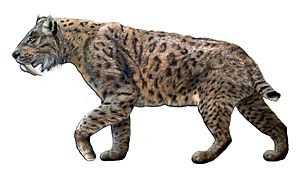 Life restoration of the Pleistocene-Holocene saber-tooth cat Smilodon
Life restoration of the Pleistocene-Holocene saber-tooth cat Smilodon - †Stegomastodon: A mastodon, an elephant relative.
- †Stockoceros: An ancient pronghorn.
- †Stylemys: An ancient tortoise.
-
†Tapirus: Ancient tapirs.A living Tapirus, or tapir
- †Teleoceras: A rhinoceros that lived in North America.
- †Thalassoleon: An ancient fur seal.
-
†Titanotylopus: A giant camel.
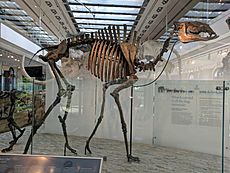 Mounted fossilized skeleton of the Miocene-Pleistocene camel Titanotylopus
Mounted fossilized skeleton of the Miocene-Pleistocene camel Titanotylopus - †Uintatherium: A large, rhino-like mammal with bony knobs on its head.
- †Zygolophodon: Another mastodon relative.
Birds from the Cenozoic Era
-
†Cathartes aura: The turkey vulture, still flying today.
 A living Cathartes aura, or turkey vulture
A living Cathartes aura, or turkey vulture - †Chendytes: Law's diving-goose, an extinct flightless goose.
-
†Falco peregrinus: The peregrine falcon, known for its incredible speed.
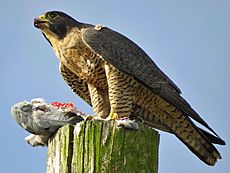 A living Falco peregrinus, or peregrine falcon
A living Falco peregrinus, or peregrine falcon -
†Fratercula cirrhata: The tufted puffin, a seabird.
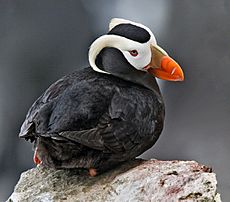 A living Fratercula cirrhata, or tufted puffin
A living Fratercula cirrhata, or tufted puffin -
†Gavia immer: The common loon, a diving bird.
 A living Gavia immer, or common loon
A living Gavia immer, or common loon -
†Geococcyx californianus: The greater roadrunner, a fast-running bird.
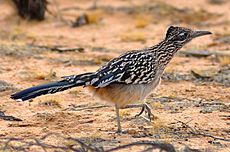 A living Geococcyx californianus, or greater roadrunner
A living Geococcyx californianus, or greater roadrunner - †Lithornis: An early, extinct bird.
- †Osteodontornis: A giant seabird with bony "teeth" on its beak.
-
†Pelagornis: Another huge pseudo-toothed bird, one of the largest flying birds ever.
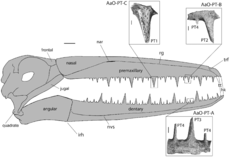 Reconstructive illustration of a fossilized skull of the Oligocene-Pleistocene pseudo-toothed bird Pelagornis, with close-up insets of its pseudo-teeth
Reconstructive illustration of a fossilized skull of the Oligocene-Pleistocene pseudo-toothed bird Pelagornis, with close-up insets of its pseudo-teeth -
†Numenius phaeopus: The whimbrel, a shorebird.
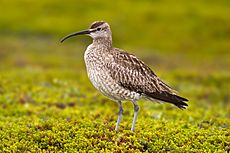 A living Numenius phaeopus, or whimbrel
A living Numenius phaeopus, or whimbrel - †Teratornis merriami: Merriam's teratorn, a massive extinct condor-like bird.
Fish and Other Marine Life from the Cenozoic Era
- †Oncorhynchus rastrosus: The "saber-toothed salmon," a giant salmon with large fangs.
-
†Porichthys notatus: The plainfin midshipman, a type of fish.
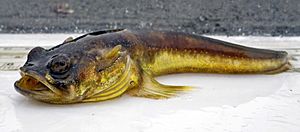 A modern Porichthys notatus, or plainfin midshipman
A modern Porichthys notatus, or plainfin midshipman -
†Galeocerdo: Tiger sharks.
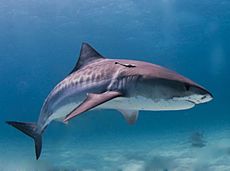 A living Galeocerdo cuvier, or tiger shark
A living Galeocerdo cuvier, or tiger shark - Notorhynchus: Cow sharks.
-
Clinocardium: Cockles, a type of clam.
 Shell of a Clinocardium cockle
Shell of a Clinocardium cockle - Conus: Cone snails.
- Dendraster excentricus: The eccentric sand dollar.
- Nassarius: Nassa mud snails.
- Pycnodonte: Oysters.
- Xenophora: Carrier shell sea snails.
Plants and Insects from the Cenozoic Era
-
Abies: Fir trees.
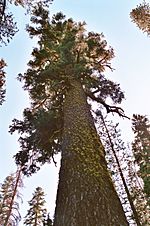 A living Abies, or fir tree
A living Abies, or fir tree -
†Buteo jamaicensis: Red-tailed hawks.
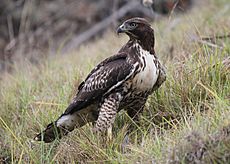 A living Buteo jamaicensis, or red-tailed hawk
A living Buteo jamaicensis, or red-tailed hawk - †Calliostoma annulatum: Purple-ring top sea snails.
-
†Crotalus viridis: Prairie rattlesnakes.
 A living Crotalus viridis, or prairie rattlesnake
A living Crotalus viridis, or prairie rattlesnake -
†Dipodomys merriami: Merriam's kangaroo rats.
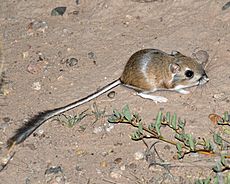 A living Dipodomys merriami, or Merriam's kangaroo rat
A living Dipodomys merriami, or Merriam's kangaroo rat -
Phrynosoma: Horned lizards.
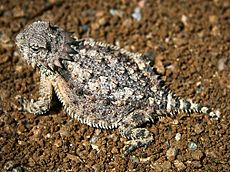 A living Phrynosoma, or horned lizard
A living Phrynosoma, or horned lizard -
†Spermophilus beecheyi: California ground squirrels.
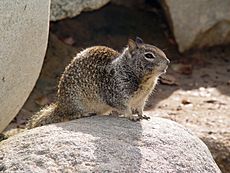 A living Otospermophilus beecheyi (formerly Spermophilus beecheyi), or California ground squirrel
A living Otospermophilus beecheyi (formerly Spermophilus beecheyi), or California ground squirrel - Syngnathus: Pipefish.
- Turcica: Sea snails.
-
†Viburnum: A type of shrub.
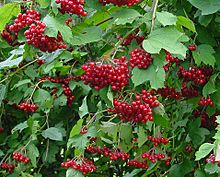 Leaves and fruit of a living Viburnum.
Leaves and fruit of a living Viburnum.
Images for kids
-
Life restoration of the Permian Chimaera relative Helicoprion
-
Restoration of the Late Triassic ichthyosaur Californosaurus
-
Diagram illustrating the Middle-Late Triassic ichthyosaur Cymbospondylus with an anachronistic human to scale.
-
Fossilized shell of the Late Cretaceous ammonoid cephalopod Parapuzosia with a human indicating its size
-
Base of the trunk of a living Sequoia tree with a human to scale
-
A living Abies, or fir tree
-
Fossilized skeleton of the Miocene seal Allodesmus
-
Restoration of an Arctodus, or short-faced bear, with a human to scale
-
Fossilized skull of the Miocene-Pliocene false saber-toothed cat Barbourofelis
-
A living Buteo jamaicensis, or red-tailed hawk
-
Life restoration of the Pliocene-Holocene camel Camelops
-
A living Cathartes aura, or turkey vulture
-
Shell of a Clinocardium cockle
-
Fossilized shell of a Conus cone snail
-
A living Crotalus viridis, or prairie rattlesnake
-
A living Dipodomys merriami, or Merriam's kangaroo rat
-
A living Falco peregrinus, or peregrine falcon
-
A living Fratercula cirrhata, or tufted puffin
-
A living Galeocerdo cuvier, or tiger shark
-
A living Gavia immer, or common loon
-
A living Geococcyx californianus, or greater roadrunner
-
Life restoration of a herd of the Miocene-Pleistocene horse Hipparion. Heinrich Harder (1920).
-
Restoration of Pliocene-Pleistocene Homotherium, or scimitar cat
-
Reconstructive illustration of the skeleton of a Mammuthus exilis, or pygmy mammoth
-
A living Numenius phaeopus, or whimbrel
-
Fossilized skeleton of the Pliocene-Pleistocene ground sloth Paramylodon
-
Reconstructive illustration of a fossilized skull of the Oligocene-Pleistocene pseudo-toothed bird Pelagornis, with close-up insets of its pseudo-teeth
-
A living Phrynosoma, or horned lizard
-
Restoration of a herd of alarmed Miocene-Pleistocene peccaries of the genus Platygonus. Charles R. Knight (1922).
-
A modern Porichthys notatus, or plainfin midshipman
-
Life restoration of the Pleistocene-Holocene saber-tooth cat Smilodon
-
A living Otospermophilus beecheyi (formerly Spermophilus beecheyi), or California ground squirrel
-
Mounted fossilized skeleton of the Miocene-Pleistocene camel Titanotylopus
-
A living Ursus americanus, or American black bear
-
Leaves and fruit of a living Viburnum.


